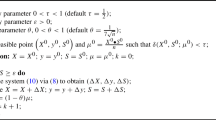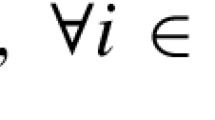Abstract
We propose a feasible primal-dual path-following interior-point algorithm for semidefinite least squares problems (SDLS). At each iteration, the algorithm uses only full Nesterov-Todd steps with the advantage that no line search is required. Under new appropriate choices of the parameter β which defines the size of the neighborhood of the central-path and of the parameter θ which determines the rate of decrease of the barrier parameter, we show that the proposed algorithm is well defined and converges to the optimal solution of SDLS. Moreover, we obtain the currently best known iteration bound for the algorithm with a short-update method, namely, \({\cal O}(\sqrt n \log (n/\varepsilon))\). Finally, we report some numerical results to illustrate the efficiency of our proposed algorithm.
Similar content being viewed by others
References
M. Achache: A new primal-dual path-following method for convex quadratic programming. Comput. Appl. Math. 25 (2006), 97–110.
M. Achache: Complexity analysis of an interior point algorithm for the semidefinite optimization based on a kernel function with a double barrier term. Acta Math. Sin., Engl. Ser. 31 (2015), 543–556.
M. Achache: A new parameterized kernel function for LO yielding the best known iteration bound for a large-update interior point algorithm. Afr. Mat. 27 (2016), 591–601.
M. Achache, N. Boudiaf: Complexity analysis of primal-dual algorithms for the semi-definite linear complementarity problem. Rev. Anal. Numér. Théor. Approx. 40 (2011), 95–106.
M. Achache, L. Guerra: A full Nesterov-Todd-step feasible primal-dual interior point algorithm for convex quadratic semi-definite optimization. Appl. Math. Comput. 231 (2014), 581–590.
M. Achache, H. Roumili, A. Keraghel: A numerical study of an infeasible primal-dual path-following algorithm for linear programming. Appl. Math. Comput. 186 (2007), 1472–1479.
M. Achache, N. Tabchouche: A full-Newton step feasible interior-point algorithm for monotone horizontal linear complementarity problems. Optim. Lett. 13 (2019), 1039–1057.
F. Alizadeh, J.-P. A. Haeberly, M. L. Overton: A New Primal-Dual Interior-Point Methods for Semidefinite Programming. Technical Report 659. Computer Science Department, Courant Institute of Mathematical Sciences, New York University, New York, 1994.
B. Alzalg: A logarithmic barrier interior-point method based on majorant functions for second-order cone programming. Optim. Lett. 14 (2020), 729–746.
S. Boyd, L. Vandenberghe: Convex Optimization. Cambridge University Press, Cambridge, 2004.
S. Boyd, L. Xiao: Least-squares covariance matrix adjustment. SIAM J. Matrix Anal. Appl. 27 (2005), 532–546.
L. B. Cherif, B. Merikhi: A penalty method for nonlinear programming. RAIRO, Oper. Res. 53 (2019), 29–38.
P. I. Davies, N. J. Higham: Numerically stable generation of correlation matrices and their factors. BIT 40 (2000), 640–651.
E. de Klerk: Interior Point Methods for Semidefinite Programming: Thesis Technische Universiteit Delf. 1997.
C. Helmberg, F. Rendl, R. J. Vanderbei, H. Wolkowicz: An interior-point method for semidefinite programming. SIAM J. Optim. 6 (1996), 342–361.
D. Henrion, J. Malick: SDLS: A Matlab package for solving conic least-squares problems. Version 1.2. Available at https://homepages.laas.fr/henrion/software/sdls/ (2009).
N. J. Higham: Computing the nearest correlation matrix — a problem from finance. IMA J. Numer. Anal. 22 (2002), 329–343.
S. Kettab, D. Benterki: A relaxed logarithmic barrier method for semidefinite programming. RAIRO, Oper. Res. 49 (2015), 555–568.
M. Kojima, S. Shindoh, S. Hara: Interior-point methods for the monotone semidefinite linear complementarity problem in symmetric matrices. SIAM J. Optim. 7 (1997), 86–125.
N. G. B. Krislock: Numerical Solution of Semidefinite Constrained Least Squares Problems: A Thesis. University of British Columbia, Vancouver, 2003.
J. Malich. A dual approach to semidefinite least-squares problems. SIAM J. Matrix Anal. Appl. 26 (2004), 272–284.
J. Malick: Applications of SDP least-squares in finance and combinatorics. CNRS, Lab. J. Kuntzmann, Grenoble. CORE Math. Prog. Seminar-11 March, 2008.
R. D. C. Monteiro: Primal-dual path-following algorithms for semidefinite programming. SIAM J. Optim. 7 (1997), 663–678.
Y. E. Nesterov, M. J. Todd: Self-scaled barriers and interior-point methods for convex programming. Math. Oper. Res. 22 (1997), 1–42.
Y. E. Nesterov, M. J. Todd: Primal-dual interior-point methods for self-scaled cones. SIAM J. Optim. 8 (1998), 324–364.
X. Qian: Continuous Methods for Convex Programming and Convex Semidefinite Programming: PhD. Thesis. Hong Kong Baptist University, Hong Kong, 2017.
M. J. Todd: A study of search directions in primal-dual interior-point methods for semi-definite programming. Optim. Methods Softw. 11 (1999), 1–46.
K. C. Toh, M. J. Todd, R. H. Tütüncü: SDPT3 — a MATLAB package for semidefinite programming, version 1.3. Optim. Methods Softw. 11 (1999), 545–581.
Y. Ye: Interior Point Algorithms: Theory and Analysis. Wiley-Interscience Series in Discrete Mathematics and Optimization. John-Wiley & Sons, Chichester, 1997.
Y. Zhang: On extending some primal-dual interior-point algorithms from linear programming to semidefinite programming. SIAM J. Optim. 8 (1998), 365–386.
Author information
Authors and Affiliations
Corresponding author
Additional information
The research has been supported for the second author by: La Direction Générale de la Recherche Scientifique et du Développement Technologique (DGRSDT-MESRS), under project PRFU number C00L03UN190120190004, Algérie.
Rights and permissions
About this article
Cite this article
Daili, C., Achache, M. An interior-point algorithm for semidefinite least-squares problems. Appl Math 67, 371–391 (2022). https://doi.org/10.21136/AM.2021.0217-20
Received:
Published:
Issue Date:
DOI: https://doi.org/10.21136/AM.2021.0217-20




